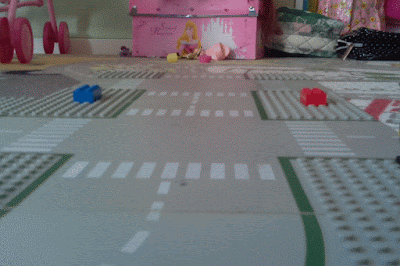We built a mount for the Raspberry Pi camera module, from Legos naturally. It came out quite nice and it holds the camera firmly in place. Then we set up some Lego roads, a car and some characters and planned a little how we are going to move them. Taking the pictures was quite easy with our setup since we had the separate button and the camera was attached to the Lego base plates, so we didn't have to worry about moving the camera when taking a picture.
Here is a gif of our first try (created using the awesome Imanee PHP library):
It came out OK, but there were a few issues with it so we weren't entirely happy with the result. The background is a bit messy, my hand was in the picture in some of the frames and the biggest issue was that the characters were a little out of focus which made them appear blurry.
 |
| Our camera rig, with the extra lens (attached with blu-tack) |
This time we also made the car come from the other direction so it doesn't block so much of the view while it's waiting. Otherwise we did it pretty much the same way. I had to try and keep Kaisla's little sister preoccupied with other things as she really wanted to help also. She did get to push the button a few times to take a couple of frames, but I had to delete some of them as she was a little bit too trigger happy with the button.
 |
| Action! |
After all the pictures were taken, we moved them to my laptop with rsync and created a video using a command-line utility called ffmpeg. If you are interested in the actual commands, you can check out this great post from Raspberry Pi Learning Resources, which describes each step with a little bit more detail.
Here is the final video:
This time it came out better and we were both happy with the result. Of course there's still room for improvement, for example the lighting is a bit bad since it was evening and there wasn't a lot of natural light. Maybe we'll do some more later on, if Kaisla keeps interested in it. Or maybe we'll try creating a time-lapse video next.

